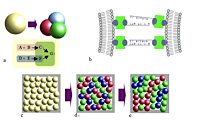An example: Many reactions are pH-dependent. Assume that we have modules Mi, which produce, as a function of pH, either product Ai or Bi. Assume further, that we have a sensory module S, which, triggered by an external chemical or optical signal, changes the pH-value in its immediate neighborhood. Depending on the relative placement of the Mi and S, a different reaction cascade is deployed. We emphasize the efficiency gain in the development process: the modules Mi can be optimized independently of each other and are applicable in different contexts.
Vesicle-based multi-step reactors are interesting for several reasons:
1 The construction of a process chain with conventional means is expensive. This holds especially if one works with very small amounts of substance. Exactly this will be important in prospective applications of biochemistry, such as personalized medicine.
2 The walls of the vesicles, the membranes, are chemically active. The crucial fact is here that the membrane contains substances which are soluble only in lipid environments, and therefore enables the direct contact of these molecules with the aqueous solution (containing water soluble substances) of the interior of the vesicles. We aim at a specific exploitation of these properties with the goal of implementing a cell-like process management.
3 Constructing two-dimensional vesicle-based reactors allows the usage of technologically well-known procedures such as lithography or self-structuring by selective coupling.
4 The small size of the vesicles leads to short distances between different reaction vessels. In macroscopic processors, substances, which are only stable for seconds can be employed only with considerable effort. On the scale of vesicles, however, a few seconds are sufficient to transport a molecule form one vessel to the other. This implies that novel reaction pathways can be exploited.
5 Processes can be controlled by optical means, e.g. laser. Regions of a two-dimensional array can be selectively excited and thereby, a novel type of spatially resolved process control can be implemented.
We are guided by the idea that micro-structured reaction environments which are built from bio-inspired materials form a suitable platform for the implementation of cell-like process management. Of course, we don't expect to exploit the biochemical potential demonstrated by living cells. But we believe that we will provide the fundamentals for a form of process management which couples molecular, supra-molecular and membrane-physical processes in a technologically novel way.



